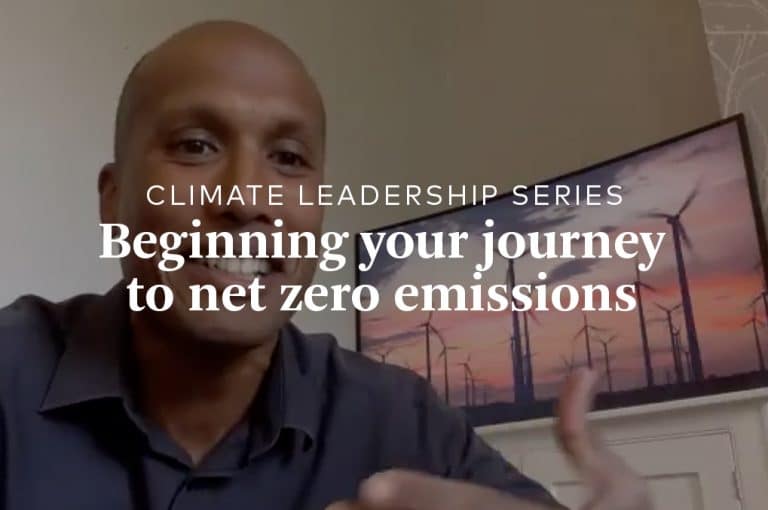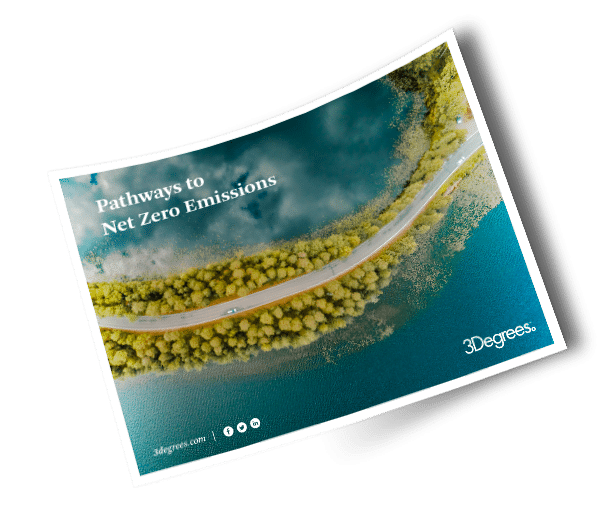To address the growing climate crisis, more organizations than ever before are setting climate goals, such as net zero, carbon neutrality, or SBTi goals. But committing to reach net zero emissions and executing on climate goals are two very different things. In this first article of a two-part series, we’ll discuss how organizations can embrace this climate opportunity, and outline the first two of four key action areas to help companies get started on their journey to zero.
Regardless of where you are in your journey, the question at the heart of your net zero strategy should be: What is your organization’s climate opportunity?
While short-term, programmatic goals are important (more on that later), it’s critical to determine how you can leverage your company’s superpowers to help create a net zero world and thrive in it. While the climate emergency requires organizations to implement rapid and deep decarbonization initiatives across all three scopes of emissions, it also presents a unique opportunity for them to innovate around products and services that can support and propel faster decarbonization, creating real value for customers, employees, and shareholders. A great example of this is the dramatic shift the transportation sector has undertaken towards electrification.
Your organization’s climate superpowers may not be immediately apparent. Creating programmatic goals can help illuminate your unique climate opportunity, while also taking immediate action to reduce your greenhouse gas (GHG) emissions. Let’s take a deeper look at each of the following key action areas:
- Business Strategy Integration
- Operational Reductions
- Value Chain Reductions
- Remaining Emissions
Business Strategy Integration
Like any other important business initiative, an organization’s decarbonization efforts should be fully integrated into its existing business strategy. Getting started will require climate intelligence on topics such as:
- Benchmarking competitive actions and goals
- Reporting and climate disclosures
- Customer and shareholder expectations
- Annual greenhouse gas (GHG) inventory
Cumulatively, these pieces of information can help you clearly articulate your business case for action, which needs to be well-articulated, supported by emissions data, and shared in the language of your most important stakeholders.
To develop your business case, a common starting place is benchmarking. What are your peers doing with respect to net zero goals? How do your organization’s climate actions stack up?
Another starting point is conducting a risk assessment and disclosure of climate risk to investors. The most common climate risk reporting framework is the TCFD framework, which refers to the Taskforce for Climate-Related Financial Disclosures, the organization that put forth recommendations on how and what to report as part of climate risk.
Underpinning all of these efforts is a need for robust climate understanding and stakeholder education. A “climate boot camp” for stakeholders may include topics such as definitions of common climate commitments, high watermark activities of leaders, a crash course in greenhouse gas accounting, and identification of your climate risks and opportunities.
Finally, any foundational work needs to include an annual GHG emissions inventory. Including important data on key emissions hotspots is required in order to set a meaningful strategy.
The most effective climate strategies take all these actions together and weave them into an organization’s current business strategy to complement and support its mission, vision, and values.
Operational Reductions
Operational reductions refer to actions an organization can take to address their emissions from activities such as:
- Electricity purchased to operate office and manufacturing facilities where fossil fuels are burned to make the electricity
- Direct burning of fossil fuels, like gallons of gas purchased to fuel company cars or natural gas used in a co-gen plant
These operational emissions, known as Scope 1 and 2 emissions, are a common starting point for reductions. Many companies also consider some Scope 3 emissions, such as those from employee commuting and company travel, as part of their operational boundaries.
To accomplish these emissions reductions, companies often find quick wins from energy efficiency projects, installing rooftop solar, and purchasing renewable energy. Renewable technology is available today and can be a valuable source of near-term action since companies have direct control over their electricity procurement.
In part two of this blog series, we’ll cover the remaining action areas: Value Chain Reductions and Addressing Remaining Emissions. In the meantime, feel free to visit our new Net Zero Resource Center to download an infographic that covers all four stages, watch a quick video about beginning your journey to net zero, and view other helpful resources.




